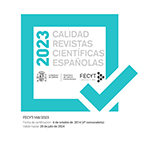Ethnopolitics of the Gypsy Evangelism and Public Sphere. Transversality, Power and Ethnicity
Abstract
The economy of Gipsy identity is sustained at present by the most active and influential sectors of the evangelical churches, acting through their social arm: FACCA (Federation of Anda-lusian Cultural Christian Associations). Religious ideas and ritual spaces have become as well a matter of ethnopolitics. Our obsession with religion has made it into a problem difficult to handle; in fact, many thinkers these days are supporting the idea that within the public sphere we should use exclu-sively the language of secular reasoning, because religious language only works outside our secular world and its use introduces premises which are acceptable only for the believers. The case we analyze here shows that (1) contemporary ethnogenesis processes like this one, in witch we can find political actors from the religious leadership, are processes linked to public policies; (2) public administrations must dialogue with these new political subjects, religious leaders and evangelical ministers, if they want these public policies to reach gypsy population; (3) secularised governments should be able to give reasonable answers to all forms of diversity in modern society, including the plurality of religious conceptions within the public sphere. In our case, these religious plurality interfaces with political recognition, ethnic minorities cultural rights and their access to public resources. As Taylor has noted, secularism (and laicism) is not about the confrontation between State and Religion, but about the response of the democratic state to all forms of diversity.Downloads
Article download
License
In order to support the global exchange of knowledge, the journal Política y Sociedad is allowing unrestricted access to its content as from its publication in this electronic edition, and as such it is an open-access journal. The originals published in this journal are the property of the Complutense University of Madrid and any reproduction thereof in full or in part must cite the source. All content is distributed under a Creative Commons Attribution 4.0 use and distribution licence (CC BY 4.0). This circumstance must be expressly stated in these terms where necessary. You can view the summary and the complete legal text of the licence.











